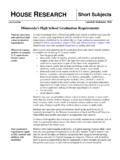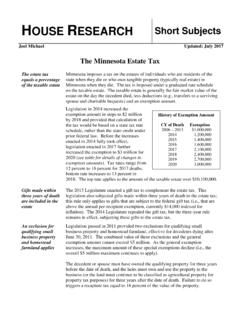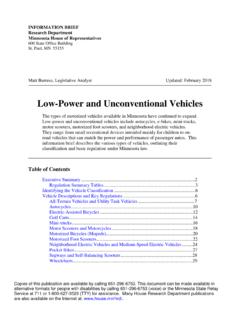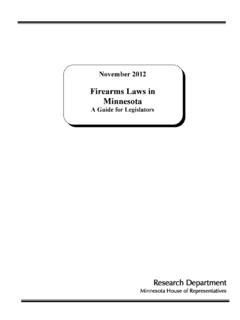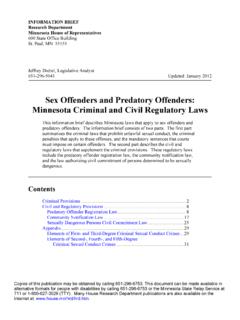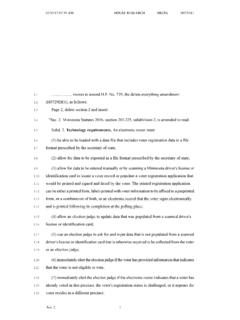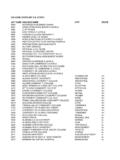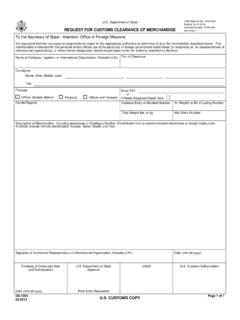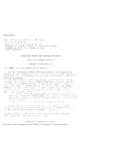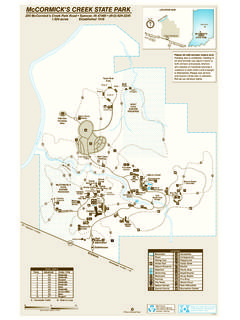Transcription of An Overview of Minnesota's DWI Laws
1 INFORMATION BRIEF. Research Department minnesota House of Representatives 600 State Office Building St. Paul, MN 55155. Ben Johnson, Legislative Analyst 651-296-8957 Updated: June 2018. An Overview of Minnesota's DWI Laws Impaired driving remains a significant issue in minnesota . In 2015, there were 25,027 impaired driving incidents recorded in the state and over 300 resulted in injuries and deaths 1. The state employs a variety of criminal and administrative consequences to address the ongoing issue of driving while impaired. This information brief provides an Overview of the major components of DWI laws, which are mainly codified in minnesota Statutes, chapter 169A. Contents Page Common Terms ..2. Prohibited Behaviors ..3. Implied Consent Law ..4. Administrative Sanctions ..5. Limited and Restricted Licenses ..8. Reinstatement After Cancellation.
2 10. Driver's License Reinstatement Criminal Penalties ..11. Records and Expungement ..15. Criminal Vehicular Operation (CVO): Homicide and Injury ..16. Special Laws ..16. 1. minnesota Impaired Driving Facts 2015, Office of Traffic Safety, minnesota Department of Public Safety (2016). Copies of this publication may be obtained by calling 651-296-6753. This document can be made available in alternative formats for people with disabilities by calling 651-296-6753 or the minnesota State Relay Service at 711 or 1-800-627-3529 (TTY). Many House Research Department publications are also available on the Internet at: House Research Department Updated: June 2018. An Overview of Minnesota's DWI Laws Page 2. Common Terms AC Alcohol concentration, a measurement of the percentage of alcohol in a person's blood. BCA Bureau of Criminal Apprehension, the centralized law enforcement agency that provides forensic laboratory analysis blood and urine samples, and oversees breath- alcohol testing procedures and instruments.
3 CVH Criminal vehicular homicide, causing the death of another person while operating a motor vehicle under conditions, including a violation of Minnesota's DWI law (Minn. Stat. ). CVO Criminal vehicular operation, causing harm to another person while operating a motor vehicle under conditions including a violation of Minnesota's DWI law (Minn. Stat. and ). DPS Department of Public Safety, a state agency that includes the Division of Driver and Vehicle Services, which oversees driver licensing and vehicle registration. DWI Driving while impaired, the act of driving, operating, or being in physical control of a motor vehicle while under the influence of alcohol, a controlled substance, or an intoxicating substance; having an alcohol concentration that exceeds the legal limits;. or having any amount or the metabolites of a schedule I or II controlled substance.
4 PBT Preliminary breath test, a test administered by a law enforcement officer at the scene of a suspected DWI, which can form the basis for an arrest, but cannot be admitted into evidence at trial. REAM Remote electronic alcohol monitoring, a program involving a system that electronically monitors the alcohol concentration of individuals in their homes or other locations to ensure compliance with conditions of pretrial release, supervised release, or probation (Minn. Stat. ). SFST Standard field sobriety test, a test of a person's physical condition (walking a line, etc.). administered by a law enforcement officer at the scene of a suspected DWI, which can form the basis for an arrest and can be described at trial. House Research Department Updated: June 2018. An Overview of Minnesota's DWI Laws Page 3. Prohibited Behaviors Minnesota's DWI law stipulates that it is a crime: (1) to drive, operate, or be in physical control 2 of any motor vehicle anywhere in the state while: under the influence of alcohol, a controlled substance, or an intoxicating substance (when the person knows, or has reason to know, that the substance has the capacity to cause impairment), or any combination of these.
5 Having an alcohol concentration (AC) of .08 or more at the time or within two hours of doing so;. having any amount or the metabolites of a schedule I or II controlled substance, other than marijuana, in the body; or if the vehicle is a commercial motor vehicle, having an AC of .04 or more at the time or within two hours of doing so;. (2) to refuse to submit to a chemical test of the person's blood, breath, or urine under minnesota Statutes, section ; or (3) to refuse to submit to a chemical test of the person's blood or urine pursuant to a warrant under minnesota Statutes, section The crime of driving while impaired also applies to motorboats in operation, snowmobiles, all- terrain vehicles, off-highway motorcycles, and off-road vehicles. Consequences A DWI arrest can result in administrative and criminal sanctions. The severity of these sanctions depends upon the facts of the current offense and the person's past record of impaired driving offenses.
6 Administrative sanctions are intended to be an immediate consequence. Upon arrest, if a person refuses or fails a chemical test for intoxication, the peace officer reports the refusal or result to the commissioner of public safety and the commissioner revokes the person's license. Other administrative sanctions that may be imposed include plate impoundment and vehicle forfeiture. Administrative sanctions are civil in nature and any related court proceedings are generally held separate from the criminal trial. 2. The court has held that to be in physical control of a vehicle, the person must be in a position to exercise domain or control over the vehicle. State v. Starfield, 481 834 (Minn. 1992). The courts have found persons to be in physical control of their vehicles while sleeping in the vehicle or being outside their vehicle.
7 See State v. Fleck, 777 233 (Minn. 2010) (evidence that person was asleep behind the wheel with keys in the console could lead a jury to find the person was in physical control of the vehicle); Frisch v. State, 2014 WL 3016152. (Minn. Ct. App. July 7, 2014) (unpublished) (person was in physical control of a vehicle even though he was 15 to 20 feet from the vehicle, when the keys were in the ignition and the vehicle was running). A passenger who grabs and turns a steering wheel exerts physical control of a motor vehicle. State v. Henderson, 890 739 (Minn. Ct. App. 2017). House Research Department Updated: June 2018. An Overview of Minnesota's DWI Laws Page 4. Criminal charges trigger a separate action in criminal court. A criminal conviction can result in incarceration, probation, fines, chemical dependency treatment, and monitoring.
8 If a person cannot afford a defense attorney, the court may appoint a public defender. A conviction produces a criminal record. The remainder of this brief will examine the implied consent law, administrative sanctions, criminal penalties, and other DWI-related laws. Implied Consent Law A person who drives, operates, or is in control of any type of motor vehicle anywhere in the state consents to a chemical test of breath, blood, or urine for the purpose of determining the presence of alcohol or controlled or intoxicating substances in the person's body. The procedure for requiring a breath test differs from the procedure for requiring a blood or urine test. Both the United States and minnesota Supreme Courts determined that an officer does not need a warrant to require that a person provide a breath sample, but does need a warrant to require that a person provide a blood or urine sample 3.
9 Before an officer can require a breath test or obtain a warrant for a blood or urine test, the officer must have probable cause to believe that a person has been driving while intoxicated. That process typically begins with an accident investigation or an investigatory stop. An officer must have a valid basis for the first stop, but the officer does not need to have evidence of a DWI. A. weaving car would be a valid basis for a stop, but an officer could also stop a vehicle for other reasons including the failure to signal a turn, lack of a taillight, or any other moving or equipment violation. An officer can expand the investigation based on new evidence including the smell of alcohol, slurred speech, or any other reasonable indication that a driver is under the influence of alcohol or a controlled substance. An officer may then administer field sobriety tests or a preliminary breath test.
10 In short, to build probable cause, the officer may: observe the impaired driving behavior and form a reasonable suspicion of an impaired driving violation;. stop and question the driver;. administer a standardized field sobriety test (SFST); and administer a preliminary breath test (PBT). 3. The minnesota court upheld the constitutionality of a warrantless breath test in State v. Bernard, 859 762 (Minn. 2015), but found that law enforcement could only obtain samples of a person's blood or urine pursuant to a valid warrant in State v. Thompson, 886 224 (Minn. 2016). The Supreme Court reached the same conclusions in Birchfield v. North Dakota, --- ----; 136 2160 (2016) and Missouri v. McNeely, 569 141 (2013). House Research Department Updated: June 2018. An Overview of Minnesota's DWI Laws Page 5. If a person refuses to cooperate, cannot cooperate because of injury or the level of intoxication, or these screening tests establish probable cause to believe that a person was driving while intoxicated, the officer may arrest the person and either demand a more rigorous evidentiary test of the person's breath, or seek a warrant to obtain a sample of the person's blood or urine.
